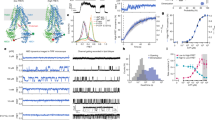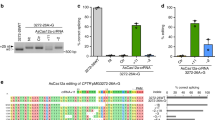Abstract
In the human CFTR only the rare exon 4− splice variant is conserved in mice. We have discovered two novel murine variants, exon 5− and exon 11b+. The exon 5− variant represents up to 40% of mRNA in all CFTR–expressing tissues and leaves the reading frame intact. The exon 11b+ variant inserts a novel exon between exons 11 and 12 with expression restricted to the testis. Two variants of 11b have been found and both introduce premature stop codons. When we expressed human CFTR variants lacking either exon 5 or exon 9 in HeLa cells, they failed to generate cAMP–mediated chloride transport, due to defective intracellular processing. The lack of conservation of splice variants between species and the inability of the more abundant splice variants to generate protein that is correctly processed argue against a physiological role and may simply represent aberrant splicing that is tolerated by the cell and organism.
This is a preview of subscription content, access via your institution
Access options
Subscribe to this journal
Receive 12 print issues and online access
$209.00 per year
only $17.42 per issue
Buy this article
- Purchase on Springer Link
- Instant access to full article PDF
Prices may be subject to local taxes which are calculated during checkout
Similar content being viewed by others
References
Collins, F.S. Cystic fibrosis: molecular biology and therapeutic implications. Science 256, 774–779 (1992).
Anderson, M.P. et al. Demonstration that CFTR is a chloride channel by alteration of its anion selectivity. Science 253, 202–207 (1991).
Anderson, M.P. et al. Nucleoside triphosphates are required to open the CFTR chloride channel. Cell 67, 775–784 (1991).
Bear, C.E. et al. Purification and functional reconstitution of the cystic fibros is transmembrane regulator. Cell 68, 809–818 (1992).
Tsui, L-C. The spectrum of cystic fibrosis mutations. Trends Genet. 8, 392–398 (1992).
Chu, C.S. et al. Variable deletion of exon9 coding sequences in cystic fibrosis transmembrane conductance regulator gene mRNA transcripts in normal bronchial epithelium. EMBO J. 10, 1355–1363 (1991).
Chu, C.S. et al. Cystic Fibrosis Transmembrane Conductance Regulator (CFTR) Gene Transcripts. EMBO J. 11, 379–380 (1992).
Bremer, S. et al. Quantitative expression patterns of multidrug-resistance P-glycoprotein(MDR1) and differentially spliced cystic-fibrosistransmembrane-conductance regulator mRNA transcripts in human epithelia. Eur. J. Biochem. 206, 137–149 (1992).
Snouwaert, J.N. et al. An animal model for cystic fibrosis made by gene targeting. Science 257, 1083–1088 (1992).
Tata, F. et al. Cloning the mouse homolog of the human cystic fibrosis transmembrane conductance regulator gene. Genomics 10, 301–307 (1991).
Elroy, S.O., Fuerst, T.R. & Moss, B. Cap-independent translation of mRNA conferred by encephalomyocarditis virus 5′ sequence improves the performance of the vaccinia virus/bacteriophage T7 hybrid expression system. Proc. natn. Acad. Sci. U.S.A. 86, 6126–6130 (1989).
Rich, D.P. et al. . Expression of the cystic fibrosis transmembrane conductance regulator corrects defective chloride channel regulation in cystic fibrosis airway epithelial cells. Nature 347, 358–363 (1990).
Gregory, R.J. et al. Maturation and function of cystic fibrosis transmembrane conductance regulator variants bearing mutations in putative nucleotide-binding domains 1 and 2. Molec. cell Biol. 11, 3886–3893 (1991).
Cheng, S.H. et al. Defective intracellular transport and processing of CFTR is the molecular basis of most cystic fibrosis. Cell 63, 827–834 (1990).
Chu, C.-S. et al. Genetic basis of variable exon9 skipping in cystic fibrosis ytansmembrane conductance regulator mRNA. Nature Genet. 3, 151–156 (1993).
Zielenski, J. et al. Identification of mutations in exons 1 through 8 of the cystic fibrosis transmembrane conductance regulator (CFTR) gene. Genomics 10, 229–235 (1991).
Fonknechten, N., Chomel, J.-C., Kitzis, A., Kahn, A. & Kaplan, J.-C. Skipping of exon 5 as a consequence of the 711+1 G> mutation in the CFTR gene. Hum. molec. Genet. 1, 281–282 (1992).
Thompson, J. et al. Alternative splicing of the neural cell adhesion molecule gene generates variant extracellular domain structure in skeletal muscle and brain. Genes Dev. 3, 348–357 (1989).
Petch, L.A. et al. A truncated, secreted form of the epidermal growth factor receptor is encoded by an alternatively spliced transcript in normal rat tissue. Molec. cell Biol. 10, 2973–2982 (1990).
Bond, R.W., Wyborski, R.J. & Gottlieb, D.I. Developmentally regulated expression of an exon containing a stop codon in the gene for glutamic acid decarboxylase. Proc. natn. Acad. Sci. U.S.A. 87, 8771–8775 (1990).
Waeber, G. & Habener, J.F. Nuclear translocation and DNA recognition signals colocalized within the bZIP domain of cyclic adenosine 3′,5′-monophosphate response element-binding protein CREB. Molec. Endocrinol. 5, 1431–1438 (1991).
Chu, C.S., Trapnell, B.C., Curristin, S.M., Cutting, G.R. & Crystal, R.G. Extensive posttranscriptional deletion of the coding sequences for part of nucleotide-bindingfold-1 in respiratory epithelial messenger RNA transcripts of the cystic fibrosis transmembrane conductance regulator gene is not associated with the clinical manifestations of cystic fibrosis. J. clin. Invest. 90, 785–790 (1992).
Chomczynski, P. & Sacchi, N. Single-step method of RNA isolation by acid guanidiniumthiocyanate-phenol-chloroform extraction. Anal. Biochem. 162, 156–159 (1987).
Kunkel, T.M. Rapid and efficient site-specific mutagenesis without phenotypic selection. Proc. natn. Acad. Sci. U.S.A. 82, 488–492 (1985).
Gregory, R.J. et al. Expression and characterization of the cystic fibrosis transmembrane conductance regulator. Nature 347, 382–386 (1990).
Cheng, S.H. et al. Phosphorylation of the R domain by cAMP-Dependent protein kinase regulates the CFTR chloride channel. Cell 66, 1027–1036 (1991).
Author information
Authors and Affiliations
Rights and permissions
About this article
Cite this article
Delaney, S., Rich, D., Thomson, S. et al. Cystic fibrosis transmembrane conductance regulator splice variants are not conserved and fail to produce chloride channels. Nat Genet 4, 426–430 (1993). https://doi.org/10.1038/ng0893-426
Received:
Accepted:
Issue Date:
DOI: https://doi.org/10.1038/ng0893-426
This article is cited by
-
Novel mutation c.1210-3C > G in cis with a poly-T tract of 5T affects CFTR mRNA splicing in a Chinese patient with cystic fibrosis
Frontiers of Medicine (2022)
-
Disease-relevant proteostasis regulation of cystic fibrosis transmembrane conductance regulator
Cell Death & Differentiation (2013)
-
Asthma and COPD in cystic fibrosis intron-8 5T carriers. A population-based study
Respiratory Research (2005)
-
Absence de corrélation génotype-phénotype dans les absences de canaux déférents
Andrologie (2001)
-
In Vivo Analysis of DNase I Hypersensitive Sites in the Human CFTR Gene
Molecular Medicine (1999)



